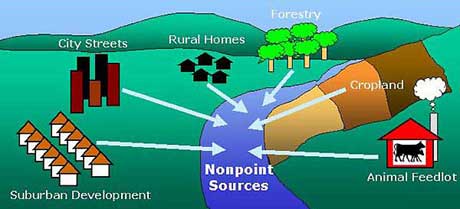This is a guest blog post by Kevin Perkins
Last week we took a look at some basic facts before delving into the causes and possible cures for what ails our oceans. This week’s installment will start to detail some of the origins of pollution and their most significant effects on the water we play in and need for survival.
One thing I would like to mention before we get started is how amazed I am about the consequences that we, as the Human Race, have been able to inflict on the world’s oceans. I am struck because, if you remember, the world is covered by 79% water. 97% of which is salt water. However, we live on only 21% of the Earth’s surface but have somehow managed to create a scenario where what we do on our 21% has had an effect on pretty much 100% of the planet! To put this in perspective for you, the oceans alone cover 127 million square miles of the earth’s surface. We are not even looking at any other water bodies for this example. Now, take your home, which is probably on a 6-9,000 sq ft. lot(I know this is a rough average. Some will be higher and some lower. But, just work with me on this one!) This is about one fifth to one seventh of an acre or so. Keep in mind that there are 640 acres in one square mile. And, we are talking about 127 million square miles of water! I hope this gives you a little idea of how little it takes for each of us to affect the larger picture.
I say all of this because most of all the pollution to the oceans comes from the 21%’ers! There are a couple of sources. One is called Nonpoint Pollution and the other is called Point Source Pollution. We are going to talk about Nonpoint this week.

The number one offender in Nonpoint Pollution is directly a result of runoff. It includes a lot of smaller sources that all add up to one big problem. Some of these sources are: septic tanks, lawn chemicals, pet waste, cars, trucks, boats, marinas, and good old fashion trash. Plus, much larger sources such as farms, ranches, construction sites, mining, and forestry operations. All over the world millions of motor vehicles drop small amounts of oil each day onto roads and parking lots. Guess where it ends up? That’s right, eventually into the oceans. Some water pollution begins as air pollution via some type of smoke stack but ends up settling onto dry surfaces that become subject to runoff or directly into waterways and oceans. Acid Rain anyone? It is not getting the headlines it used to but still is a problem. Top soil and silt from fields and construction sites also run off into rivers that end up dumping into the oceans as well wreaking havoc all the way through the ecosystems they pass through. And, can make river and ocean waters unsafe for humans and wildlife. Have you ever had a beach closure near where you live; especially, after a rainstorm? Guess what? The perfect example of Nonpoint Pollution! As you can imagine, the coastal areas that support shellfish growing are definitely affected by this. In addition, Nonpoint pollution can affect countries’ economies as many are dependent on coastal and marine jobs, shipping, boating, recreational and commercial fishing, and tourism.
Although the concentration of some pollutants from runoff may be lower than the concentration from a point source, the total amount of a pollutant delivered from nonpoint sources may be higher because the pollutants come from many places. This is why it is difficult to control because it comes from multiple locations.
Now, there is some good news…Monitoring in recent years has increased in many parts of the world as the cause of Ocean Conservation has gained in notoriety. Plus, as a matter of practicality, we have to preserve our precious resources as our very survival depends on them. In addition to monitoring, some controls have been developed to help reduce the overall amount of Nonpoint Pollution. Even though the exact locations of Nonpoint Pollution cannot be identified, we know enough to at least make a decent effort in the areas we do know about. For example, Buffer strips of grass around impervious materials that can absorb various pollutants, retention ponds to capture runoff and storm water, constructed wetlands, more porous paving materials that allow drainage into the ground, sediment fences, straw barriers around construction sites, better crop management, and new techniques to reduce erosion in forestry and mining operations, making sure trash ends up in the right places, and many more that I won’t take the time to list here.
So, you may be asking…”What can I do to help?” Here are a few very basic things you can do to help at least inhibit Nonpoint Pollution: Plant grass, trees and shrubs in bare areas, properly dispose of household chemicals and motor oils, use pesticides and fertilizers as little as possible and maybe even employ nature’s own remedies such as Ladybugs and Praying Mantises, keep trash in its place and out of storm drains, organize a local “Clean Up Day”, and recycle plastic, glass, and paper. Less trash means less material in the waste stream, and reducing the waste stream is the goal of all measures to control nonpoint source pollution.
If every one of us 21%’ers did at least a few of these preventative ideas, can you imagine the positive impact we could have?


